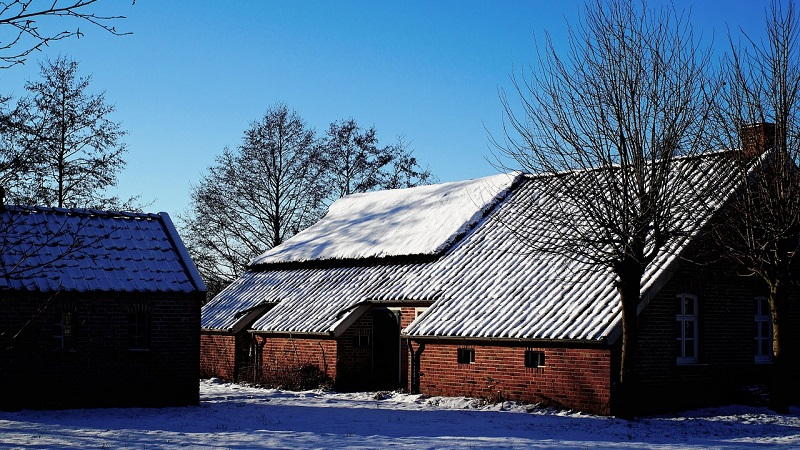As fall goes by and temperatures start to drop, flowers and trees prepare for dormancy. While it seems like everything in your garden has stopped, there is actually a lot happening under the soil until it gets frozen. Newly transplanted shrubs and trees, hardy bulbs, and perennials are still growing roots and drawing moisture or nutrients on the soil. And more importantly, your plants require protection to get through the frigid, cold days in winter. With that in mind, below are some useful tips on how to prepare your garden and get around winter in a breeze.
1. Clean paving and paths

The first thing you should do is to clear up all the debris and leaves in your garden. It is much simpler when the trees are still bare and everything is dry and crisp.
Also, it is worth giving the paving a comprehensive cleanup with some soapy water and stiff brushed. This would help ensure safety and prevent slipping when the snow arrives during the winter. Alternatively, you can use a pressure washer and a leaf blower to give the area a blast.
2. Take care trees and shrubs
Prune any unnecessary branches on structural trees to enhance the overall shape. If necessary, give the hedges in your garden a final trim before the snows and frosts arrive. Also, get rid of any damaged, diseased, or dead branches to prevent their stems from rubbing together and forming deformities or wounds.
To add some interests to the space during winter days, plant shrubs and trees with brightly coloured barks. They are great options for small gardens where a few years of interests are desirable. Some of the most popular varieties include cinnamon maple, snake bark maples, paper birch, or Tibetan cherry. In addition, consider Shrubby dogwoods with striking tones in yellow, scarlet, and flame-orange.
3. Preserve the borders
Remove annuals which have completed their show and cut back any herbaceous perennials in the borders near the ground when they start to die. Additionally, it is worth tidying up the borders and getting rid of any dead weeds, leaves, or foliage.
Clear stems from your perennials and trim lawn edges, but make sure to keep anything with striking seed heads as they look stunning when frosted. Likewise, avoid cutting back deciduous grasses and leave them until late winter because the dead foliage can help protect the crown of the plant.
Next, it’s time to empty the compost bins of rotted, old materials. Spread them all over fresh soil in the garden to get prepared for the spring and make everything look better during the winter. Just make sure to discard weeds separately.
Keep in mind that thin borders can be ugly, while narrow strips will provide little space for your plants to develop. Thus, it is better to be generous and make big borders.
4. Protect plants

Move all pots that contain tender varieties, such as palms, Agapanthus, or Cannas, into a greenhouse or conservatory to protect them against frosts and snows.
Next, wrap a polypropylene fabric called horticultural fleece all over the trunks of palm trees on the ground and apply a thick layer of bark mulch around their base to help them fight against frosts.
Small shrubs, roses, and deciduous would be lifted bare-root and planted again before the middle of March. Other plants, particular conifers and evergreens, require rootballing.
5. Get the lawn prepared
Use a rake to get rid of moss and thatch on the whole lawn. This will allow it to grow and breathe more freely. If a lot of moss invade your garden, then the chance is that you might deal with drainage problems. The most effective way to resolve this issue is to go around with a garden fork or a spike aerator. Also, consider combining with moss killer options and specially manufactured lawn feed to help the lawn prepared for the winter.
6. Deal with water features
Attempt to prevent your water features or pond from clogging up with debris or leaves by covering those areas with a net. If you haven’t cleaned the pond for many years, making its water turn murky, then now it’s the best time to deal with it when other creatures are dormant. For fish, make sure that the surface of the water doesn’t freeze completely during frost.
These are some great ideals to try in your garden:
7. Plant spring-flowering bulbs
Plan to grow your spring bulbs before frosts come in to prepare your garden for the winter. From daffodils and crocus to snowdrops, they all favour free-draining and well-fertilised soil, so make sure to dig in a lot of sharp sand for a gradual release of minerals and nutrients which would feed those plans during the season.
During this process, the key is to grow at 2 or 3 times the depth of the plant itself. Additionally, spacing can work well at 2 or 3 times the bulb’s width. And for the most dramatic and natural effects, consider planting the same species in large drifts.
8. Add colour and greenery
Just because chilling days in the winter are the time for dormancy, does not necessarily mean that you cannot have a beautiful and vibrant garden. Try to grow some evergreen shrubs such as Phormium tenax to establish a significant structure along with deciduous shrubs.
Also, you can fill some containers with violas, polyanthus, and winter pansies, one category in each pot. For more interesting and creative displays, combine them with bulbs, small shrubs, perennials, as well as evergreen grasses.
9. Add lighting to your garden
Once you have done all of these tasks to protect your plants and prepare the garden for the coming winter. It’s time to create some personal touches with outdoor lighting. Having solar lights in your backyard can be a great way to cheer up the space during the dark and chilling days. Make a careful plan to focus on topiary, trees, and sculptural structures. Spotlights can be the most versatile and flexible options that could be installed at various angles to create numerous lighting effects.







